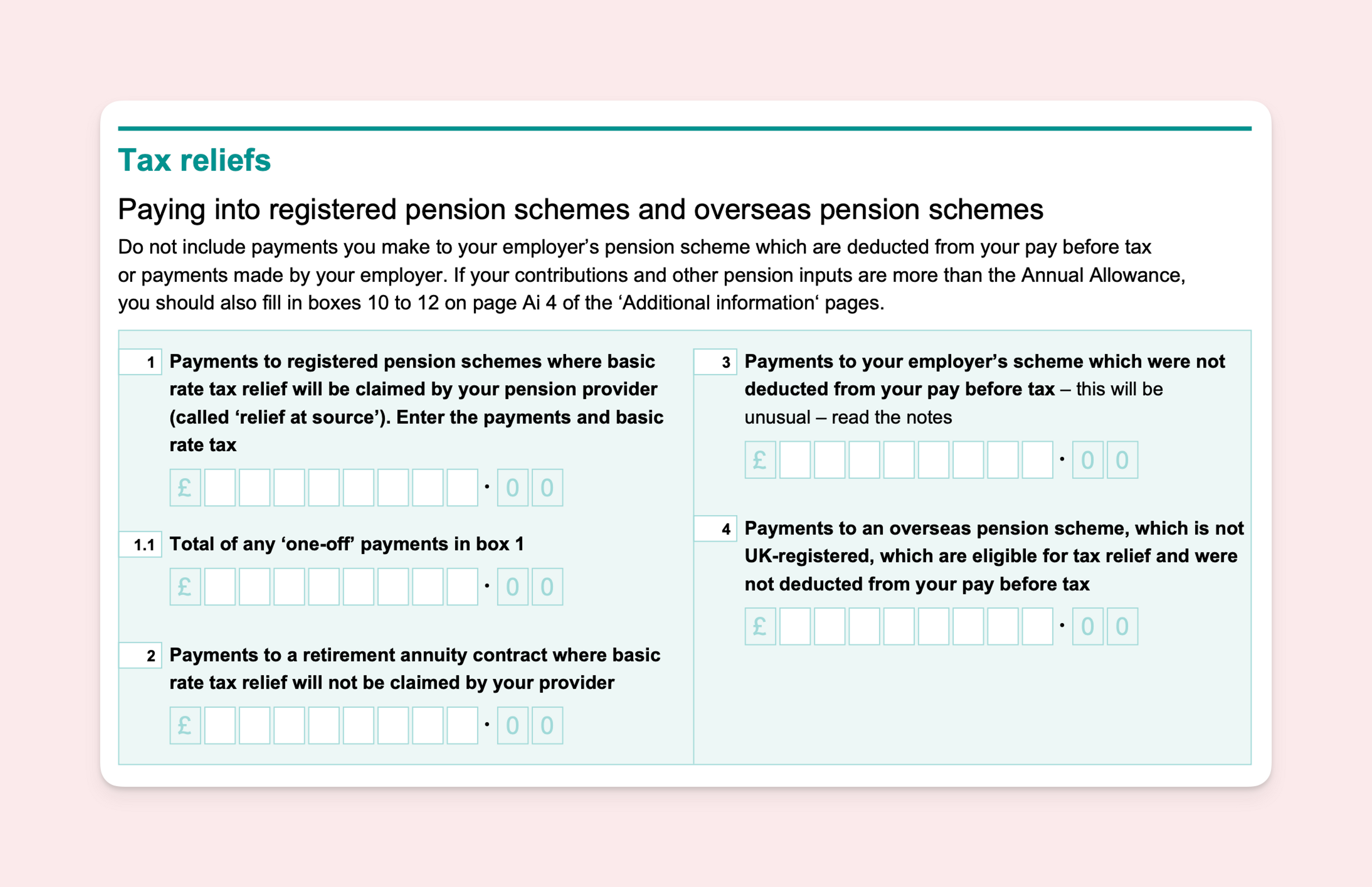How to add Pension Contributions to your Self Assessment Tax Return
- By
- Murray Humphrey

It’s always a great time to check if you’re owed any unpaid tax relief from your pension. In this article, we’ll walk you through how to correctly add your pension contributions to your tax return and, most importantly, make sure you don’t miss out on any tax relief.
Do I put pension contributions on my tax return?
Ok, first thing’s first: do you actually need to enter your pension contributions on your self-assessment tax return? Just because you’re currently paying into a pension scheme, does not mean you need to enter your contributions during self-assessment.
Here's the main takeaway: you should only include pension contributions on your tax return if you're a high earner, or you're making significant payments into your pension. Let's look at a couple of examples.
If you’re employed
If you’re paying into a workplace pension scheme organised by your employer and are earning under £50,270 (for the 2023/24 tax year) you won’t need to declare your pension contributions on your tax return. That’s because most employer pension schemes will claim tax relief at source (after your wages are taxed) for you. This also applies if you’re part of a salary sacrifice pension. It is, however, worth double-checking your tax relief is being added for you as some schemes will not do this automatically. You can contact your pension provider if you aren’t sure.
If you’re self-employed
If you work for yourself and pay into a private pension, you similarly won’t need to declare any payments if your income for the tax year is less than £50,270. That’s because your pension provider should claim basic rate tax relief from the government for you and add it into your pension pot automatically.
What about higher earners?
If you fall into the higher or additional rate tax band (i.e. you earned over £50,270 this year), declaring your pension contributions in your tax return may be in your interests. That’s because you’ll be able to claim extra tax relief on your pension contributions if they have been deducted after Income tax and National Insurance have been taken from your pay (often called relief at source).
You’re probably aware that any payments into a workplace or private pension benefit from 20% basic rate tax relief automatically. Your pension provider claims this back from the government on your behalf.
However, if you are taxed at 40% (or 45% for additional rate taxpayers) on a portion of your earnings, you may essentially still be owed that extra 20% or 25% tax back on your contributions. More on how to do this in our How to claim higher rate tax relief on pension contributions article.
Where do I put pension contributions on my tax return?
Your private pension contributions for the year will need to be added to the main section of your tax return (form SA100). This is the part that focuses on:
- income from dividends
- charitable donations
- benefits such as the State pension and child benefits
You’ll need the section titled ‘Tax reliefs’. Here’s what that looks like in a paper tax return.

Question 1: Relief at Source Pension Contributions
For personal pension contributions made under the ‘Relief at Source’ system, use Question 1 of the SA100 form. This box is specifically for contributions to registered pension schemes operating under relief at source. You should enter the total amount of your personal contributions for the tax year, plus the basic rate tax relief added by your pension provider.
For example, if you paid £800 into your pension, and your provider claimed £200 as basic rate tax relief (20%), you would report £1,000.
Question 1.1 Total of any ‘one-off payments’ refers to the sum of any lump-sum contributions made to your pension during the tax year. These one-off payments are distinct from your regular pension contributions and might include:
- Additional Voluntary Contributions (AVCs): Extra amounts you might choose to pay into your pension to boost your savings.
- Lump-Sum Investments: Single, substantial payments you make into your pension pot, perhaps from an inheritance, a bonus, or other windfalls.
Question 2 and 3: Other Pension Contributions
If you contribute to a retirement annuity contract or an employer’s scheme not deducted from pay before tax, these contributions are reported in Question 2 and 3, respectively. These boxes are used for pension contributions where tax relief is not claimed at source and needs to be reclaimed.
Question 4: Overseas Pension Schemes
For contributions to eligible overseas pension schemes, use Question 4. This is relevant if you're claiming tax relief for contributions to a pension scheme outside the UK that qualifies under HMRC guidelines.
Additional Information Section
If you have any one-off or unusual pension contributions, or if there are specific details you need to highlight, use the ‘Additional Information’ section on the SA100 form. This section can be helpful for providing context or clarity to your reported figures.
How to calculate pension contributions for a tax return
If you need to declare your pension contributions during self-assessment, you'll need to enter your total gross pension contributions for the tax year - including the automatic 20% basic rate tax bonus.
To find this number, look for your annual pension statement. You’ll need to add every payment you’ve made, as well as the tax relief. This should be available online - if not, your pension provider will be able to help.
With Penfold, you can check this year’s contributions from your dashboard. Simply sign in and use the amount just above ‘Saved this year’ in your savings ring. This number should include your latest tax relief bonuses - remember to double-check any pending transactions under the ‘Activity’ tab. You can also download your complete transaction history from the ‘Activity’ tab.
Are tax return pension contributions gross or net?
It’s important to remember that any contributions you add to your tax return should be gross and include any basic rate tax relief. Essentially, you need to tell the government how much has been added to your pension in total for this tax year. Once you’ve entered this, it’s time to start thinking about claiming back any extra tax relief you’re owed.
How to claim higher rate pension tax relief on your self-assessment
To claim additional tax relief, you’ll need to enter your total gross pension contributions for the tax year - including the 20% basic rate tax bonus. Once you’ve calculated your annual pension contributions, submit your tax return and HMRC will process your additional tax relief. Remember, you can also claim tax relief for previous years if you missed out on the past.
Your tax refund will take the form of:
- Paying less tax this year
- An update in your tax code (so you pay less tax next year)
- A tax rebate
You don’t need to put your tax rebate into your pension. You’re free to use your rebate as you please - although adding to your pot is a great way to help it grow.
Make sure you claim tax relief before the online tax return deadline of January 31st. Missed the online tax return date? You can also write to HMRC with details on how much you’ve paid. For more details on this, head to the government’s dedicated page on claiming a tax refund.
The only other thing to be wary of is your annual pension allowance.
What happens if I exceed my pension annual allowance?
Most people are only entitled to claim tax relief on pension contributions up to £60,000 (or 100% of their earnings) each year.
The only exception is the tapered annual allowance, which affects very high earners. If you earn more than £200,000 a year, we recommend visiting the government’s site on calculating tapered annual allowance to avoid any surprise tax charges.
Here’s the main takeaway: if you exceed your annual pension allowance, you may have to pay an extra tax charge. If you have gone over your annual allowance, it’s your responsibility to let HRMC know.
Do employer pension contributions count towards the annual allowance?
All contributions into your pension, whether they are from you, your employer or a third party count towards your annual allowance.
Maximise Pension Contributions with the Carry Forward Rule
For individuals looking to make larger contributions to their pension, understanding the Carry Forward Rule is highly beneficial. This rule allows you to make use of any unused annual allowances from the previous three tax years, potentially increasing the amount you can contribute to your pension while still receiving tax relief.
How the Carry Forward Rule Works:
- Eligibility: To use the Carry Forward Rule, you must have been a member of a registered pension scheme during the years from which you are carrying forward unused allowances.
- Calculation: Check how much of the Annual Allowance you have used in the last three tax years. Any unused portion can be added to your allowance for the current tax year.
- Limits: The maximum you can carry forward is the unused portion of the Annual Allowance from each of the previous three tax years.
The information provided in this article is intended for general informational purposes and should not be construed as professional financial or tax advice. Pension contributions, tax relief, and related regulations can be complex and vary based on individual circumstances.
Tax treatment depends on the individual circumstances of each individual and may be subject to change in the future.

Murray Humphrey
Penfold